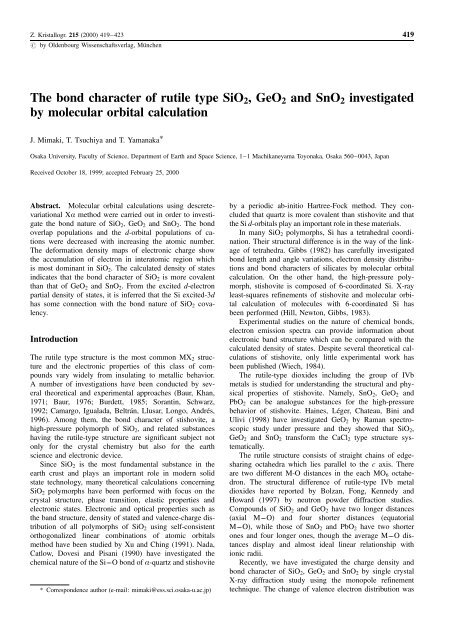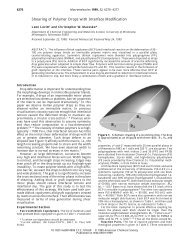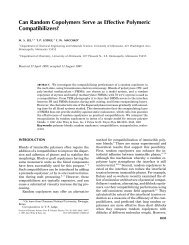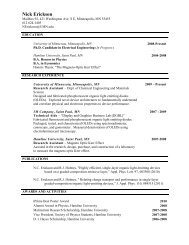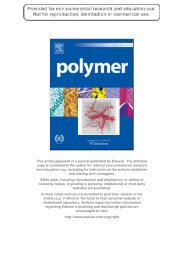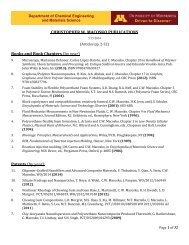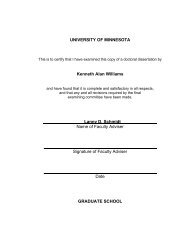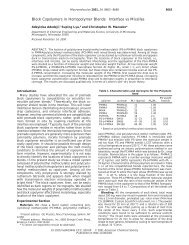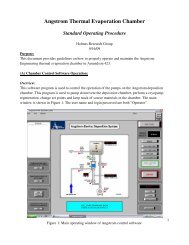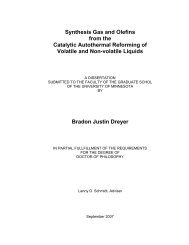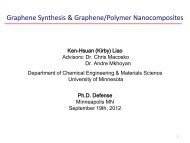The bond character of rutile type SiO2, GeO2 ... - Unit's home page.
The bond character of rutile type SiO2, GeO2 ... - Unit's home page.
The bond character of rutile type SiO2, GeO2 ... - Unit's home page.
Create successful ePaper yourself
Turn your PDF publications into a flip-book with our unique Google optimized e-Paper software.
Z. Kristallogr. 215 2000) 419±423 419<br />
# by Oldenbourg Wissenschaftsverlag, MuÈnchen<br />
<strong>The</strong> <strong>bond</strong> <strong>character</strong> <strong>of</strong> <strong>rutile</strong> <strong>type</strong> SiO 2 , GeO 2 and SnO 2 investigated<br />
by molecular orbital calculation<br />
J. Mimaki, T. Tsuchiya and T. Yamanaka*<br />
Osaka University, Faculty <strong>of</strong> Science, Department <strong>of</strong> Earth and Space Science, 1±1 Machikaneyama Toyonaka, Osaka 560±0043, Japan<br />
Received October 18, 1999; accepted February 25, 2000<br />
Abstract. Molecular orbital calculations using descretevariational<br />
Xa method were carried out in order to investigate<br />
the <strong>bond</strong> nature <strong>of</strong> SiO 2 , GeO 2 and SnO 2 . <strong>The</strong> <strong>bond</strong><br />
overlap populations and the d-orbital populations <strong>of</strong> cations<br />
were decreased with increasing the atomic number.<br />
<strong>The</strong> deformation density maps <strong>of</strong> electronic charge show<br />
the accumulation <strong>of</strong> electron in interatomic region which<br />
is most dominant in SiO 2 . <strong>The</strong> calculated density <strong>of</strong> states<br />
indicates that the <strong>bond</strong> <strong>character</strong> <strong>of</strong> SiO 2 is more covalent<br />
than that <strong>of</strong> GeO 2 and SnO 2 . From the excited d-electron<br />
partial density <strong>of</strong> states, it is inferred that the Si excited-3d<br />
has some connection with the <strong>bond</strong> nature <strong>of</strong> SiO 2 covalency.<br />
Introduction<br />
<strong>The</strong> <strong>rutile</strong> <strong>type</strong> structure is the most common MX 2 structure<br />
and the electronic properties <strong>of</strong> this class <strong>of</strong> compounds<br />
vary widely from insulating to metallic behavior.<br />
A number <strong>of</strong> investigations have been conducted by several<br />
theoretical and experimental approaches Baur, Khan,<br />
1971; Baur, 1976; Burdett, 1985; Sorantin, Schwarz,<br />
1992; Camargo, Igualada, BeltraÂn, Llusar, Longo, AndreÂs,<br />
1996). Among them, the <strong>bond</strong> <strong>character</strong> <strong>of</strong> stishovite, a<br />
high-pressure polymorph <strong>of</strong> SiO 2 , and related substances<br />
having the <strong>rutile</strong>-<strong>type</strong> structure are significant subject not<br />
only for the crystal chemistry but also for the earth<br />
science and electronic device.<br />
Since SiO 2 is the most fundamental substance in the<br />
earth crust and plays an important role in modern solid<br />
state technology, many theoretical calculations concerning<br />
SiO 2 polymorphs have been performed with focus on the<br />
crystal structure, phase transition, elastic properties and<br />
electronic states. Electronic and optical properties such as<br />
the band structure, density <strong>of</strong> stated and valence-charge distribution<br />
<strong>of</strong> all polymorphs <strong>of</strong> SiO 2 using self-consistent<br />
orthogonalized linear combinations <strong>of</strong> atomic orbitals<br />
method have been studied by Xu and Ching 1991). Nada,<br />
Catlow, Dovesi and Pisani 1990) have investigated the<br />
chemical nature <strong>of</strong> the Si ±O <strong>bond</strong> <strong>of</strong> a-quartz and stishovite<br />
* Correspondence author e-mail: mimaki@ess.sci.osaka-u.ac.jp)<br />
by a periodic ab-initio Hartree-Fock method. <strong>The</strong>y concluded<br />
that quartz is more covalent than stishovite and that<br />
the Si d-orbitals play an important role in these materials.<br />
In many SiO 2 polymorphs, Si has a tetrahedral coordination.<br />
<strong>The</strong>ir structural difference is in the way <strong>of</strong> the linkage<br />
<strong>of</strong> tetrahedra. Gibbs 1982) has carefully investigated<br />
<strong>bond</strong> length and angle variations, electron density distributions<br />
and <strong>bond</strong> <strong>character</strong>s <strong>of</strong> silicates by molecular orbital<br />
calculation. On the other hand, the high-pressure polymorph,<br />
stishovite is composed <strong>of</strong> 6-coordinated Si. X-ray<br />
least-squares refinements <strong>of</strong> stishovite and molecular orbital<br />
calculation <strong>of</strong> molecules with 6-coordinated Si has<br />
been performed Hill, Newton, Gibbs, 1983).<br />
Experimental studies on the nature <strong>of</strong> chemical <strong>bond</strong>s,<br />
electron emission spectra can provide information about<br />
electronic band structure which can be compared with the<br />
calculated density <strong>of</strong> states. Despite several theoretical calculations<br />
<strong>of</strong> stishovite, only little experimental work has<br />
been published Wiech, 1984).<br />
<strong>The</strong> <strong>rutile</strong>-<strong>type</strong> dioxides including the group <strong>of</strong> IVb<br />
metals is studied for understanding the structural and physical<br />
properties <strong>of</strong> stishovite. Namely, SnO 2 , GeO 2 and<br />
PbO 2 can be analogue substances for the high-pressure<br />
behavior <strong>of</strong> stishovite. Haines, LeÂger, Chateau, Bini and<br />
Ulivi 1998) have investigated GeO 2 by Raman spectroscopic<br />
study under pressure and they showed that SiO 2 ,<br />
GeO 2 and SnO 2 transform the CaCl 2 <strong>type</strong> structure systematically.<br />
<strong>The</strong> <strong>rutile</strong> structure consists <strong>of</strong> straight chains <strong>of</strong> edgesharing<br />
octahedra which lies parallel to the c axis. <strong>The</strong>re<br />
are two different M-O distances in the each MO 6 octahedron.<br />
<strong>The</strong> structural difference <strong>of</strong> <strong>rutile</strong>-<strong>type</strong> IVb metal<br />
dioxides have reported by Bolzan, Fong, Kennedy and<br />
Howard 1997) by neutron powder diffraction studies.<br />
Compounds <strong>of</strong> SiO 2 and GeO 2 have two longer distances<br />
axial M ±O) and four shorter distances equatorial<br />
M ±O), while those <strong>of</strong> SnO 2 and PbO 2 have two shorter<br />
ones and four longer ones, though the average M ±O distances<br />
display and almost ideal linear relationship with<br />
ionic radii.<br />
Recently, we have investigated the charge density and<br />
<strong>bond</strong> <strong>character</strong> <strong>of</strong> SiO 2 , GeO 2 and SnO 2 by single crystal<br />
X-ray diffraction study using the monopole refinement<br />
technique. <strong>The</strong> change <strong>of</strong> valence electron distribution was
420 J. Mimaki, T. Tsuchiya and T. Yamanaka<br />
clarified. <strong>The</strong> result will be presented in another paper<br />
Yamanaka, Kurashima, Mimaki, submitted).<br />
In the present paper we have studied the <strong>bond</strong> <strong>character</strong><br />
<strong>of</strong> <strong>rutile</strong> <strong>type</strong> SiO 2 , GeO 2 and SnO 2 by molecular orbitals<br />
calculation. <strong>The</strong> key <strong>of</strong> this work is the systematic<br />
research <strong>of</strong> these dioxides. We discuss the differences <strong>of</strong><br />
the dioxides in terms <strong>of</strong> Mulliken population analysis,<br />
density <strong>of</strong> states and charge density distributions.<br />
DV-Xa molecular orbitals calculation<br />
In order to investigate the <strong>bond</strong> <strong>character</strong> <strong>of</strong> <strong>rutile</strong> structure<br />
SiO 2 , GeO 2 and SnO 2 , the cluster discrete variational<br />
DV)-Xa molecular orbitals calculations Averill, Ellis,<br />
1973; Rosen, Ellis, Adachi, Averill, 1976) were carried<br />
out. <strong>The</strong> DV-Xa method is based upon a self-consistentfield<br />
Hartree-Fock-Slater approximation and has been applied<br />
to a wide range <strong>of</strong> materials Kowada, Adachi, Tatsumisago,<br />
Minami, 1992; Tanaka, Kawai, Adachi, 1995;<br />
Nakatsugawa, Iguchi, 1997). In this method, one-electron<br />
Hamiltonian h is,<br />
h ˆ T i ‡ V n ‡ V c ‡ V xc ;<br />
…1†<br />
where T i ,V n ,V c and V xc is the kinetic energy potential, the<br />
Coulomb interaction with nuclear, the Coulomb interaction<br />
between electrons and exchange-correlation potential, respectively.<br />
In the Hartree-Fock-Slater method, the exchange-correlation<br />
potential is given by<br />
<br />
V xa ˆ 3a 3r 1=3<br />
; …2†<br />
4p<br />
Where r…r† is the local charge density<br />
<strong>The</strong> molecular orbitals <strong>of</strong> the cluster are represented by<br />
linear combination <strong>of</strong> atomic orbitals LCAO) expressed<br />
as<br />
w l ˆ P C ij c i ;<br />
…3†<br />
where w l ; c i and C ij is the lth molecular orbital, the ith<br />
atomic orbital and the coefficients <strong>of</strong> linear combinations<br />
determined by self-consistent procedure, respectively.<br />
Compared with the Hartree-Fock methods, this method<br />
has advantages as follows:<br />
1) It can calculate the electronic structure <strong>of</strong> the substances<br />
including heavy atoms within same precision as<br />
light ones because the atomic orbitals are numerically generated.<br />
2) By using Xa exchange-correlation potential a<br />
fixed at 0.7), the computation time is greatly reduced and<br />
relatively large-scale calculation is possible. <strong>The</strong> details <strong>of</strong><br />
the computational treatments <strong>of</strong> the DV-Xa method have<br />
been reported in Adachi, Tsukada, and Satoko 1978).<br />
<strong>The</strong> atomic basis 1s) 2 ns) 2 np) 2 nd) 0 for each cation<br />
where n is 3, 4 and 5 for Si, Ge, Sn, respectively and<br />
1s) 2 2s) 2 2p) 4 for oxygen were adopted as the initial<br />
state. Moreover, we placed formal charges at each atom<br />
sites around the cluster with cation as ‡4, <strong>of</strong> oxygen as<br />
2 in order to include the effect <strong>of</strong> the Madelung potential.<br />
<strong>The</strong> [MO 6 M 10 O 8 ] 16‡ M ˆ Si, Ge, Sn) and<br />
[MO 6 M 10 O 38 ] 44 M ˆ Si, Ge) clusters in D 2h mmm)<br />
point symmetry were employed. Since there is no large<br />
difference among the results obtained from these clusters,<br />
we concluded the size effects <strong>of</strong> cluster are small. <strong>The</strong><br />
structural data <strong>of</strong> clusters were taken from experimental<br />
results Yamanaka et al. Submitted).<br />
Results and discussion<br />
Mulliken population analysis<br />
1) [MO 6 M 10 O 8 ] 16‡ M ˆ Si, Ge, Sn) and 2)<br />
[MO 6 M 10 O 38 ] 44 M ˆ Si, Ge) clusters are shown in<br />
Fig. 1. <strong>The</strong> latter cluster was not calculated in the case <strong>of</strong><br />
M ˆ Sn, since we could not have a good self-consistency<br />
in it. Table 1 shows the results <strong>of</strong> Mulliken population<br />
analysis. <strong>The</strong> <strong>bond</strong> overlap population, which is a useful<br />
parameter to discuss the covalency, is decreased on increasing<br />
atomic number. <strong>The</strong> exited d-orbital population is<br />
also decreased from Si to Sn. <strong>The</strong> Mulliken population<br />
analysis is widely used in the field <strong>of</strong> quantum chemistry<br />
in order to analyze the local electronic properties. However,<br />
it is noted that absolute values <strong>of</strong> Mulliken population<br />
analysis are strongly dependent on the atomic basis<br />
set. On the contrary, they have comparable values when<br />
they are calculated with same conditions.<br />
a<br />
b<br />
Fig. 1. Cluster model <strong>of</strong> a) [MO 6 M 10 O 8 ] 16‡ and b) [MO 6 M 10 O 38 ] 44 .<br />
<strong>The</strong> gray and open spheres are Si and O atoms, respectively.<br />
Table 1. <strong>The</strong> results <strong>of</strong> Mulliken population analysis.<br />
a) cluster: [MO 6 M 10 O 8 ] 16‡ M ˆ Si, Ge, Sn)<br />
n<br />
ns<br />
np<br />
nd<br />
Si Ge Sn<br />
3<br />
0.50<br />
0.83<br />
0.51<br />
4<br />
0.70<br />
0.88<br />
0.23<br />
5<br />
0.62<br />
0.75<br />
0.18<br />
net charge 2.16 2.18 0.43<br />
ovelap population eq)<br />
overlap population ax)<br />
b) cluster: [MO 6 M 10 O 38 ] 44<br />
n<br />
ns<br />
np<br />
nd<br />
0.44<br />
0.42<br />
M ˆ Si, Ge)<br />
Si<br />
3<br />
0.52<br />
0.87<br />
0.53<br />
0.37<br />
0.33<br />
Ge<br />
4<br />
0.70<br />
0.87<br />
0.21<br />
net charge 2.08 2.20<br />
overlap population eq)<br />
overlap population ax)<br />
0.45<br />
0.43<br />
0.36<br />
0.32<br />
0.26<br />
0.25
<strong>The</strong> <strong>bond</strong> <strong>character</strong> <strong>of</strong> <strong>rutile</strong> <strong>type</strong> SiO 2 , GeO 2 and SnO 2 421<br />
Density <strong>of</strong> states <strong>of</strong> SiO 2 , GeO 2 , SnO 2<br />
<strong>The</strong> calculated total and partial densities <strong>of</strong> states DOS)<br />
<strong>of</strong> SiO 2 , GeO 2 and SnO 2 are shown in Fig. 2 and Fig. 3,<br />
respectively. <strong>The</strong> DOS can provide information on the<br />
electron system as a function <strong>of</strong> energy. <strong>The</strong> highest occupied<br />
molecular orbitals HOMO) is set to be zero. <strong>The</strong>se<br />
DOS(arb. units)<br />
SiO 2<br />
GeO 2<br />
SnO 2<br />
-30 -20 -10 0 10<br />
Energy (eV)<br />
Fig. 2. Total density <strong>of</strong> states TDOS) <strong>of</strong> SiO 2 , GeO 2 and SnO 2 . <strong>The</strong><br />
full, dashed and dotted line corresponds to SiO 2 n ˆ 3), GeO 2<br />
n ˆ 4) and SnO 2 n ˆ 5), respectively.<br />
DOS(arb. units)<br />
0.5<br />
0<br />
0.5<br />
0<br />
0.5<br />
0<br />
4.0<br />
0<br />
4.0<br />
Mns<br />
SiO 2 ( n=3 )<br />
GeO 2 ( n=4 )<br />
SnO 2 ( n=5 )<br />
Mnp<br />
Mnd<br />
O2s<br />
O2p<br />
0<br />
-30 -20 -10 0 10<br />
Energy(eV)<br />
Fig. 3. Partial density <strong>of</strong> states PDOS) <strong>of</strong> SiO 2 , GeO 2 and SnO 2 .<br />
<strong>The</strong> full, dashed and dotted lines correspond to SiO 2 n ˆ 3), GeO 2<br />
n ˆ 4) and SnO 2 n ˆ 5), respectively.<br />
DOS were obtained by convolution <strong>of</strong> MO levels with a<br />
Gaussian broadening function with a full width at halfmaximum<br />
FWHM) <strong>of</strong> 0.5 eV. <strong>The</strong> results <strong>of</strong> the total density<br />
<strong>of</strong> states TDOS) for SiO 2 stishovite) is in good<br />
agreement with Xu and Ching 1991). <strong>The</strong> partial density<br />
<strong>of</strong> states PDOS) is in very good agreement with Nada<br />
et al. 1990).<br />
Experimental results <strong>of</strong> X-ray photoelectron spectroscopy<br />
and ultraviolet photoelectron spectroscopy XPS and<br />
UPS) can provide information about density <strong>of</strong> states <strong>of</strong><br />
valence bands. Barr, Mohsenian and Chen 1991) have examined<br />
XPS spectra <strong>of</strong> sputter-deposited thin films <strong>of</strong> IVb<br />
oxides. According to their experiment, the covalency ionicity)<br />
affects the bandwidth <strong>of</strong> these oxides. <strong>The</strong> more<br />
covalent, the wider the bandwidth. Our results <strong>of</strong> total<br />
DOS are roughly in agreement with theirs concerning to<br />
bandwidths which gradually shrink from SiO 2 to SnO 2 .<br />
SiO 2 has the most dispersive bandwidth due to the enhanced<br />
covalency and hybridization compared to GeO 2<br />
and SnO 2 , as shown in Fig. 2.<br />
<strong>The</strong> role played by d-orbitals in Si ±O <strong>bond</strong> formation<br />
is a controversial problem Gibbs, Downs, Boisen, 1994,<br />
Simunek, Vackar, Wiech, 1993). <strong>The</strong> electron emission<br />
spectra about a-quartz and stishovite have been analyzed<br />
by Wiech 1984). Si K-emission bands <strong>of</strong> stishovite are<br />
considerably different from a-quartz, while those <strong>of</strong> the Si<br />
L 2,3 -emission bands are similar. <strong>The</strong> Si K- and Si L-emission<br />
bands reflect the Si p-like and Si s/d-like electrons <strong>of</strong><br />
the valence band, respectively. Simunek et al. 1993) have<br />
concluded that Si 3d-orbital does not participate in the<br />
Si ±O <strong>bond</strong>. This conclusion is based upon the fact that Si<br />
L 2,3 -emission bands composed <strong>of</strong> their s and d constituents<br />
are insensitive to the local crystal structure <strong>of</strong> a-<br />
quartz and stishovite.<br />
On the other hand, Gibbs et al. 1994) concluded that<br />
the d-orbitals <strong>of</strong> Si play a small but important role in governing<br />
the geometry, electron density distribution and<br />
spectral properties. As seen from Fig. 3, the population <strong>of</strong><br />
d-electron on Ge and Sn is much less than that <strong>of</strong> Si.<br />
Thus, it is implied that the d-orbitals <strong>of</strong> cation affects the<br />
difference <strong>of</strong> local geometry <strong>of</strong> the crystal structure <strong>of</strong><br />
these materials.<br />
Electron density distributions <strong>of</strong> SiO 2 ,<br />
GeO 2 and SnO 2<br />
<strong>The</strong> deformation density maps subtracted crystal electron<br />
density from isolated atom electron density) <strong>of</strong> SiO 2 ,<br />
GeO 2 and SnO 2 are shown in Fig. 4 and the degree <strong>of</strong><br />
localization <strong>of</strong> electron density distribution <strong>of</strong> Si ±O,<br />
Ge ±O and Sn ±O has been compared.<br />
Many attempts in order to establish a direct link between<br />
the height/position <strong>of</strong> a build-up <strong>of</strong> the Drr) map<br />
and the ionic/covalent <strong>character</strong> <strong>of</strong> the <strong>bond</strong> had been made<br />
earlier. However, we can not quantitatively evaluate the<br />
specific covalency <strong>of</strong> these <strong>bond</strong>s by deformation density<br />
maps. Dunitz and Sieler 1983) discovered the absence <strong>of</strong> a<br />
build-up <strong>of</strong> the Drr) density in interatomic regions for a<br />
number <strong>of</strong> covalent systems with NN, CN and CO <strong>bond</strong>s.<br />
Thus, the accumulation <strong>of</strong> electron density in the <strong>bond</strong>ing<br />
region is not a necessary condition <strong>of</strong> covalent <strong>bond</strong>s.
422 J. Mimaki, T. Tsuchiya and T. Yamanaka<br />
(a)<br />
(b)<br />
(c)<br />
O<br />
O<br />
O<br />
O<br />
O<br />
O<br />
Si<br />
Ge<br />
Sn<br />
O<br />
O<br />
O<br />
O<br />
O<br />
O<br />
(d)<br />
O<br />
(e)<br />
O<br />
(f)<br />
O<br />
O<br />
Si<br />
O<br />
O<br />
Ge<br />
O<br />
O<br />
Sn<br />
O<br />
O<br />
O<br />
O<br />
Fig. 4. Deformation density map <strong>of</strong> SiO 2 , GeO 2 and SnO 2 .a) SiO 2<br />
equatorial <strong>bond</strong> plane. b) GeO 2 equatorial <strong>bond</strong> plane. c) SnO 2<br />
equatrial <strong>bond</strong> plane. d) SiO 2 axial/equatrial <strong>bond</strong> plane. e) GeO 2<br />
axial/equatrial <strong>bond</strong> plane. f) SnO 2 axial equatrial <strong>bond</strong> plane. <strong>The</strong><br />
Despite the above comment, the deformation density<br />
maps can provide meaningful information and are worth<br />
while calculation, since the relative charge transfer is at<br />
least shown in these results. <strong>The</strong>re is an increase <strong>of</strong> electron<br />
density in the interatomic region between Si and O;<br />
such increase <strong>of</strong> Ge ±O <strong>bond</strong> is less than that <strong>of</strong> Si ±O<br />
<strong>bond</strong>, and that <strong>of</strong> Sn ±O <strong>bond</strong> is the last <strong>of</strong> the three dioxides.<br />
<strong>The</strong> ratio <strong>of</strong> the electron density <strong>of</strong> M ±Oeq)/<br />
M ±Oax) is decreasing with increasing atomic number.<br />
Comparison with monopole refinement results<br />
Together with calculations described above, we have executed<br />
monopole refinements based on X-ray single crystals<br />
diffraction intensities <strong>of</strong> SiO 2 , GeO 2 and SnO 2 Yamanaka<br />
et al. submitted). Our calculations are in good<br />
agreement with the refined results and other experimental<br />
data Baur, Khan 1971; Hill et al. 1983; Spackman, Hill,<br />
Gibbs, 1987; Bolzan et al. 1997) which indicates that the<br />
electron distributions are more localized with increasing<br />
atomic number.<br />
Conclusion<br />
Molecular orbital calculations using descrete-variational<br />
Xa method have been performed in order to study the<br />
<strong>bond</strong> nature <strong>of</strong> SiO 2 , GeO 2 and SnO 2 . Our results indicate<br />
full and dashed lines correspond to positive and negative density, respectively.<br />
Dot-dashed lines indicate the zero level. <strong>The</strong> contour values<br />
range from 0.04 to 0.04 e a.u.) 3 with an increment <strong>of</strong> 0.005 e<br />
a.u.) 3 .<br />
that SiO 2 is the most covalent and the ionicity increases<br />
with increase atomic number. Moreover, the population <strong>of</strong><br />
d-orbital <strong>of</strong> cation decreases with increase atomic number.<br />
Thus, we may conclude that there are some correlations<br />
between the d-orbital <strong>of</strong> cations and the covalency <strong>of</strong><br />
M ±O <strong>bond</strong>s.<br />
Acknowledgments. This work is partly supported by the Grant-in-Aid<br />
A2)-10304044 and B2)-11694076) <strong>of</strong> Ministry <strong>of</strong> Education, Sport<br />
and Culture, Japan.<br />
References<br />
Adachi, H.; Tsukada, M.; Satoko, C.: Discrete Variational Xa Cluster<br />
Calculations I. Application to Metal Clusters. J. Phys. Soc. Jpn.<br />
45 1978) 875±883.<br />
Averill, F. W.; Ellis, D. E.: An efficient numerical multicenter basis<br />
set for molecular orbital calculation: Application to FeCl 4 . J.<br />
Chem. Phys. 59 1973) 6412±6418.<br />
Barr, T. L.; Mohsenian, M.; Chen, L. M.: XPS valence band studies<br />
<strong>of</strong> the <strong>bond</strong>ing chemistry <strong>of</strong> germanium oxides and related systems.<br />
Appl. Surf. Sci. 51 1991) 71±87.<br />
Baur, W. H.; Khan, A. A.: Rutile-Type Compounds. IV. SiO 2 , GeO 2<br />
and a Comparison with other Rutile-Type Structures. Acta Crystallogr.<br />
B27 1971) 2133±2139.<br />
Baur, W. H.: Rutile-Type Compounds. V. Refinement <strong>of</strong> MnO 2 and<br />
MgF 2 . Acta Crystallogr. B32 1976) 2200±2204.<br />
Bolzan, A. A.; Fong, C.: Kennedy, B. J.; Howard, C. J.: Structural<br />
Studies <strong>of</strong> Rutile-Type Metal Dioxides. Acta Crystallogr. B53<br />
1997) 373±380.<br />
Burdett, J.: Electronic Control <strong>of</strong> the Geometry <strong>of</strong> Rutile and Related<br />
Structures. Inorg. Chem. 24 1985) 2244±2253.
<strong>The</strong> <strong>bond</strong> <strong>character</strong> <strong>of</strong> <strong>rutile</strong> <strong>type</strong> SiO 2 , GeO 2 and SnO 2 423<br />
Camargo, A. C.; Igualada, J. A.; BeltraÂn, A.; Llusar, R.; Longo, E.;<br />
AndreÂs, J.: An ab initio perturbed ion study <strong>of</strong> structural properties<br />
<strong>of</strong> TiO 2 , SnO 2 and GeO 2 <strong>rutile</strong> lattices. Chem. Phys. 212<br />
1996) 381±391.<br />
Dunitz, J. D.; Sieler, P.: <strong>The</strong> absence <strong>of</strong> <strong>bond</strong>ing electron density in<br />
certain covalent <strong>bond</strong>s as revealed by X-ray analysis. J. Am.<br />
Chem. Soc. 105 1983) 7056±7058.<br />
Gibbs, G. V.: Molecules as models for <strong>bond</strong>ing in silicates. Am.<br />
Mineral. 67 1982) 421±450.<br />
Gibbs, G. V.; Downs, J. W.; Boisen, M. B.: <strong>The</strong> elusive SiO <strong>bond</strong><br />
SILICA. In: Reviews in Mineralogy vol. 29. Eds. P. J. Heaney,<br />
C. T. Prewitt, G. V. Gibbs), p. 331±368 Am. Meneral., Washington,<br />
D.C. 1994.<br />
Haines, J.; LeÂger, J. M.; Chateau, C.; Bini, R.; Ulivi, L.: Ferroelastic<br />
phase transition in <strong>rutile</strong>-<strong>type</strong> germanium dioxide at high pressure.<br />
Phys. Rev. B58 1998) R2909-R2912.<br />
Hill, R. J.; Newton, M. D.; Gibbs, G. V.: A Crystal Chemical Study<br />
<strong>of</strong> Stishovite. J. Solid State Chem. 47 1983) 185±200.<br />
Kowada, Y.; Adachi, H.; Tatsumisago, M.; Minami, T.: Application <strong>of</strong><br />
the DV-Xa cluster method to calculations <strong>of</strong> the electronic structure<br />
<strong>of</strong> silicate and phosphate glasses. J. Non-Cryst. Solids 150<br />
1992) 318±321.<br />
Nada, R.; Catlow, C. R. A.; Dovesi, R.; Pisani, C.: An ab-initio Hartree-Fock<br />
Study <strong>of</strong> a-quartz and stishovite. Phys. Chem. Miner.<br />
17 1990) 353±362.<br />
Nakatsugawa, H.; Iguchi, I.: Electronic structures in VO 2 using the<br />
periodic polarizable point-ion shell model and DV-Xa method.<br />
Phys. Rev. B55 1997) 2157±2163.<br />
RoseÂn, A.; Ellis, D. E.; Adachi, H.; Averill, F. W.: Calculations <strong>of</strong><br />
molecular ionization energies using a self-consistent-charge Hartree-Fock-Slater<br />
method. J. Chem. Phys. 65 No.9 1976) 3629±<br />
3634.<br />
Simunek, A.; Vackar, J.; Wiech, G.: Local s, p and d charge distributions<br />
and x-ray emission band <strong>of</strong> SiO 2 : a-quartz and stishovite. J.<br />
Phys.: Condens. Matter 5 1993) 867±874.<br />
Sorantin, P. I.; Schwarz, K.: Chemical Bonding in Rutile-Type Compounds.<br />
Inorg. Chem. 31 1992) 567±576.<br />
Spackman, M. A.; Hill, R. J.; Gibbs, G. V.: Exploration <strong>of</strong> Structure<br />
and Bonding in Stishovite with Fourier and Pseudoatom Refinement<br />
Methods Using Single Crystal and Powder X-ray Diffraction<br />
Data. Phys. Chem. Miner. 14 1987) 139±150.<br />
Tanaka, I.; Kawai, J.; Adachi, H.: Near-edge x-ray-absorption fine<br />
structure <strong>of</strong> crystalline silicon dioxides. Phys. Rev. B52 1995)<br />
11733±11739.<br />
Wiech, G.: X-ray spectroscopic investigation <strong>of</strong> the electronic structure<br />
<strong>of</strong> a-quartz and stishovite SiO 2 ). Solid State Commun. 52<br />
1984) 807±809.<br />
Xu, Y.; Ching, W. Y.: Electronic and optical properties <strong>of</strong> all polymorphic<br />
forms <strong>of</strong> silicon dioxide. Phys. Rev. B44 1991) 11048±<br />
11059.<br />
Yamanaka, T.; Kurashima, R.; Mimaki, J.: X-ray diffraction study <strong>of</strong><br />
<strong>bond</strong> <strong>character</strong> <strong>of</strong> <strong>rutile</strong>-<strong>type</strong> SiO 2 , GeO 2 and SnO 2 . Z. Kristallogr.<br />
215 2000) 424±428.


